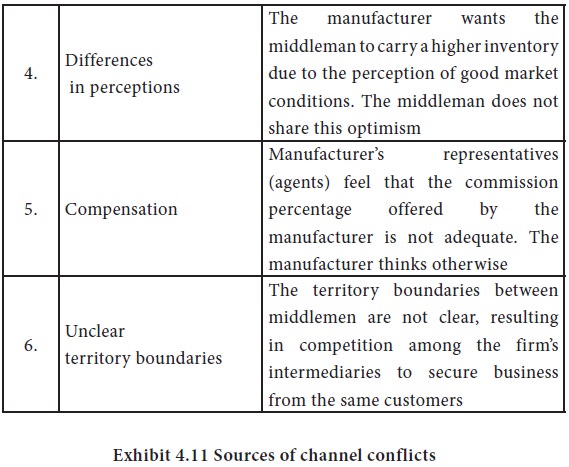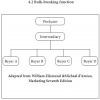Home | ARTS | Marketing Management
|
Managing Channel Members And Their Conflicts - Structure and Design of Marketing Channels
MARKETING MANAGEMENT - Structure and Design of Marketing Channels
Managing Channel Members And Their Conflicts - Structure and Design of Marketing Channels
Posted On :
After a particular channel is selected, the marketer must manage or administer the channel members or intermediaries. Managing channel members include
Managing Channel Members And Their Conflicts
Selection of intermediaries or middlemen is a continuous process because some of them leave the channel or get terminated by the marketer. Hence it is not part of channel design. It is necessary for the marketer to determine criteria or factors for selection of intermediaries. These criteria differ depending on the type of middlemen and the firm’s particular product/market conditions. Some of the common factors considered
The marketer must continuously motivate his intermediaries to achieve long-term success. Motivating the intermediaries to achieve top performance should start with understanding the middlemen’s needs, perceptions and outlook. The quality of support from middlemen will depend on the motivational techniques used and incentives offered.
Even though a manufacturer’s channel design is well done, there will be some conflict because of the differences in the objectives and perceptions of the channel members. The conflicts or tensions between the channel members can damage channel performance. Marketers should periodically undertake surveys of intermediaries or conduct formal/ informal discussions with them to assess the areas or sources of conflicts. Some of the sources of conflict are indicated in Exhibit 4.11.


The channel conflicts can be controlled or managed in several ways, including:
1. Effective communication network
2. Joint goal-setting
3. Diplomacy
4. Mediation
5. Arbitration and
6. Developing a vertical marketing system (which is described in the next section).
An effective communication network between the manufacturer and the intermediaries can be developed through periodic formal and informal meetings and co-optation of intermediaries in board of directors or advisory committees. In joint-goal setting, the channel members come to an agreement on the super-ordinate (or fundamental) goals they jointly seek.
After a particular channel is selected, the marketer must manage or administer the channel members or intermediaries. Managing channel members include
a. Selecting intermediaries
b. Motivating channel members or middlemen
c. Controlling or managing channel conflicts, and
d. Evaluating performance of channel members
a. Selecting intermediaries
b. Motivating channel members or middlemen
c. Controlling or managing channel conflicts, and
d. Evaluating performance of channel members
Selecting intermediaries
Selection of intermediaries or middlemen is a continuous process because some of them leave the channel or get terminated by the marketer. Hence it is not part of channel design. It is necessary for the marketer to determine criteria or factors for selection of intermediaries. These criteria differ depending on the type of middlemen and the firm’s particular product/market conditions. Some of the common factors considered
Motivating middlemen
The marketer must continuously motivate his intermediaries to achieve long-term success. Motivating the intermediaries to achieve top performance should start with understanding the middlemen’s needs, perceptions and outlook. The quality of support from middlemen will depend on the motivational techniques used and incentives offered.
Controlling channel conflicts
Even though a manufacturer’s channel design is well done, there will be some conflict because of the differences in the objectives and perceptions of the channel members. The conflicts or tensions between the channel members can damage channel performance. Marketers should periodically undertake surveys of intermediaries or conduct formal/ informal discussions with them to assess the areas or sources of conflicts. Some of the sources of conflict are indicated in Exhibit 4.11.


The channel conflicts can be controlled or managed in several ways, including:
1. Effective communication network
2. Joint goal-setting
3. Diplomacy
4. Mediation
5. Arbitration and
6. Developing a vertical marketing system (which is described in the next section).
An effective communication network between the manufacturer and the intermediaries can be developed through periodic formal and informal meetings and co-optation of intermediaries in board of directors or advisory committees. In joint-goal setting, the channel members come to an agreement on the super-ordinate (or fundamental) goals they jointly seek.
Such goals can be market share leadership, customer satisfaction or product/service quality in a highly competitive market where survival and success of channel members depend on their performance and cooperation. The channel members may resort to diplomacy, mediation or arbitration, when conflicts are sharp. Diplomacy is used when the conflict is resolved through discussions between the persons from both the parties. In mediation a neutral third party tries to conciliate the interests of the two parties. In arbitration, both the parties present their arguments to a third party (i.e. the arbitrator) and agree to accept the arbitration decision.
It is a good policy for the marketer to evaluate the performance of each channel member periodically. An evaluation is useful to know which intermediaries are achieving favourable results and which are not. The intermediaries not performing well need to be counseled, re-trained, re-motivated or terminated. An evaluation data can also be used while deciding which type of middlemen to be used. The factors or criteria to be used for an evaluation of middlemen’s performance can include sales achieved versus sales quota, average inventory levels, customer delivery performance, customer complaints, cooperation in market feedback, support for new products and new customers generated.
Evaluating channel members
It is a good policy for the marketer to evaluate the performance of each channel member periodically. An evaluation is useful to know which intermediaries are achieving favourable results and which are not. The intermediaries not performing well need to be counseled, re-trained, re-motivated or terminated. An evaluation data can also be used while deciding which type of middlemen to be used. The factors or criteria to be used for an evaluation of middlemen’s performance can include sales achieved versus sales quota, average inventory levels, customer delivery performance, customer complaints, cooperation in market feedback, support for new products and new customers generated.
Tags : MARKETING MANAGEMENT - Structure and Design of Marketing Channels
Last 30 days 2169 views














